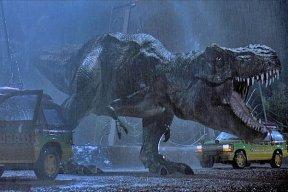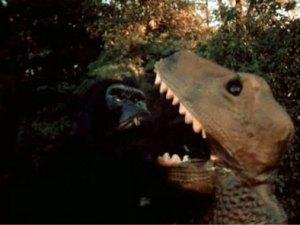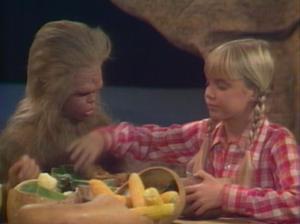It is no secret that movies with monsters, the bigger the better, are nothing short of an absolute blast, from Roger Corman’s B-Flicks to a prestigious  epic like Jurassic Park, they fascinate fans young and old. One person who shares this passion is acclaimed author and historian who specializes in such films, Mark F. Berry. Berry is an expert on all things relating to classic horror and science fiction and holds writing credits in such popular publications as Filmfax, Video Watchdog, and Monsters from the Vault. He is also the author of the definitive guide to dinosaurs on the silver screen in his book, The Dinosaur Filmography, in which he discusses films throughout the years which feature these extinct beasts. Recently, I was given the honor of meeting Mr. Berry discuss this book as well as his love of classic genre works. It is an excellent book and a must have for film fans, it is available in paperback and can be purchased here.
epic like Jurassic Park, they fascinate fans young and old. One person who shares this passion is acclaimed author and historian who specializes in such films, Mark F. Berry. Berry is an expert on all things relating to classic horror and science fiction and holds writing credits in such popular publications as Filmfax, Video Watchdog, and Monsters from the Vault. He is also the author of the definitive guide to dinosaurs on the silver screen in his book, The Dinosaur Filmography, in which he discusses films throughout the years which feature these extinct beasts. Recently, I was given the honor of meeting Mr. Berry discuss this book as well as his love of classic genre works. It is an excellent book and a must have for film fans, it is available in paperback and can be purchased here.
You specialize in writing about classic horror and science fiction. What do you consider the “classic” era to be?
You can define “classic” however you want to, basically not current…Probably the 30′s through the 50′s. In the 30′s you had the Universal Horrors; and the Golden Age of Hollywood with the old black and white genre films. You had the old dark house films and King Kong of course which is the greatest movie ever made. Of course in the 50′s you had King Kong re-released which was movie of the year in re-release which kick started the giant movie craze of the Cold War. Most of the classic science fiction and giant monster and giant bug movies that would become classics came from that era.
Why do you think there was a shift in cinema from the more gothic Universal type horror to the big radioactive creatures leaving a path of destruction?
Part of that came from the fear of the atom, Americans especially had a weird relationship with atomic power. On the one hand, they feared it, but, on the other hand, you could go and get an “atomic burger” or wash your clothes at “atomic laundry.” So, having the atom be represented by the giant dinosaur tearing up New York who gets killed in the end gave comfort to those audience. You could vanquish the monster even though you could not vanquish the Cold War or the arms race, or un-invent the hydrogen bomb. But sitting in the theater you got the feeling that we could beat it.
How did you get your start in writing?
Back in the early 1990′s I was building up my collection of films that I had seen and loved growing up. And I’ve always loved to write so I just started writing these short 2 or 3 paragraph: essay, thoughts, synopsis. I think The Beast From 20,000 Fathoms was the very first movie I ever wrote about, and as time went on I started getting more and more elaborate with the notes I was taking on each one. I had become e-mail pen pals with a lady named, Judy Harris who used to write movie reviews for Cinefantastique. I sent her a couple of my short essays. She gave me great feedback and encouraged me to pursue
Your book, now available in paperback is called The Dinosaur Filmography, can you tell us a little bit about that?

How did you decide what movies were worth writing about?
In the preface I tell the reader what qualified as a dinosaur and what did not. The criteria I laid out for the book is that if the creature is referred to in the film as a “dinosaur” it goes in the book regardless of what it looked like. Thankfully, the 1998 version of Godzilla with Matthew Broderick has a line where he mentions that the creature is a “modern mutation” so that saved me from that one.
Was there any obscure dinosaur flicks that you really had to look hard to find?
There were several but truthfully the most obscure one, is one I didn’t think I would ever be able to see. It was never released in any format it was a replacement animation, film, which is different from stop-motion animation, that was started in the 1950′s and was not finished until the 1970′s it was called Emilio and His Magical Bull. It had two showings in 1975 and that was it, and it featured a dream sequence where the little boy protagonist Emilio dreams of his prized bull fighting an Allosaurus type dinosaur. Luckily, I got in contact with someone who worked on the 1993 straight-to-video Dinosaur Island and he had access to a 16mm print of it and he made a crude VHS copy for me. And I was always very grateful to him for it.
What is one movie you wrote about that you believe most people have not seen and really need to see?
There was a movie in the mid-90′s called Loch Ness which portrays Nessie as a natural prehistoric creature. And it is very sentimental and not snarky or sarcastic if you’re too jaded it’s not for you but if you are one of those people who still cry when Bambi’s mother gets shot you will appreciate it. It’s a very sweet and enjoyable little movie.
On a more pure dinosaur movie level, one of the giant dinosaur movies from the 1950′s that’s not as well known, The Giant Behemoth, it’s a redundant title I know but over in Britain it was just known as, Behemoth the Sea Monster. In many ways it’s a British remake of The Beast From 20,000 Fathoms, with whom it shares a director, but it’s got this great British feel to it. It’s neat because, other than having to accept that a giant radioactive dinosuar is terrorizing London, the actual procedural stuff that our heroes perform is all based on acutal science. Gene Evans as the American scientist and Andre Morell who was his British counterpart actually have a great chemistry which makes the film that much more enjoyable. In one of his final films, the legendary Willis O’Brien supervised bringing the Sauropoda type dinosaur to life with his protege Pete Peterson.It’s almost heresy, but the way they got the dinosaur move with this great gate when it walked, is better than some of the stuff Ray Harryhausen could do.
On the flipside what is the worst movie you write about?
The one I like to cover on the bad side is called The Mighty Gorga, it’s a very low budget production from 1969 starring

So what interesting projects do you have on the way?
In an issue of Video Watchdog coming out this summer, I have a combination article/interview that coincide with the 50th anniversary of Dr. Strangleove or: How I Learned to Stop Worrying and Love the Bomb. It is an article I wrote about the film itself where I look back at it and talk about how a movie that is fifty years old and specific to its time is still relevant. Despite the fall of the Berlin Wall and the end of the Soviet Union, the film is just as applicable and entertaining as it was in 1964. That leads into an interview Shane Rimmer, a Canadian immigrant to Great Britain who played Slim Pickens’ co-pilot. Among other things, he discusses how he auditioned for a movie he did not know much about before going on a USO type tour through Europe and discovering he got the part in Dr. Strangelove. He has a lot of great tales about the three months and his actor friends spent playing a bomber crew and working with Stanley Kubrick. He has actually had a long a varied career, doing work on great genre projects like; Doctor Who, Thunderbirds, James Bond, and UFO. In fact the interview is so in-depth that while the Strangelove aspects will be published in the magazine the entire interview will be available on the Video Watchdog web site.
I have one final question for you Mr. Berry; what film/TV show/comic book really inspired you and stuck with you?
I hope this doesn’t sound lame or geeky, but to honestly answer your question I’m going to have to say the original Land of the
Thank you very much for your time, Mr. Berry. And remember The Dinosaur Filmography is available in paperback.

